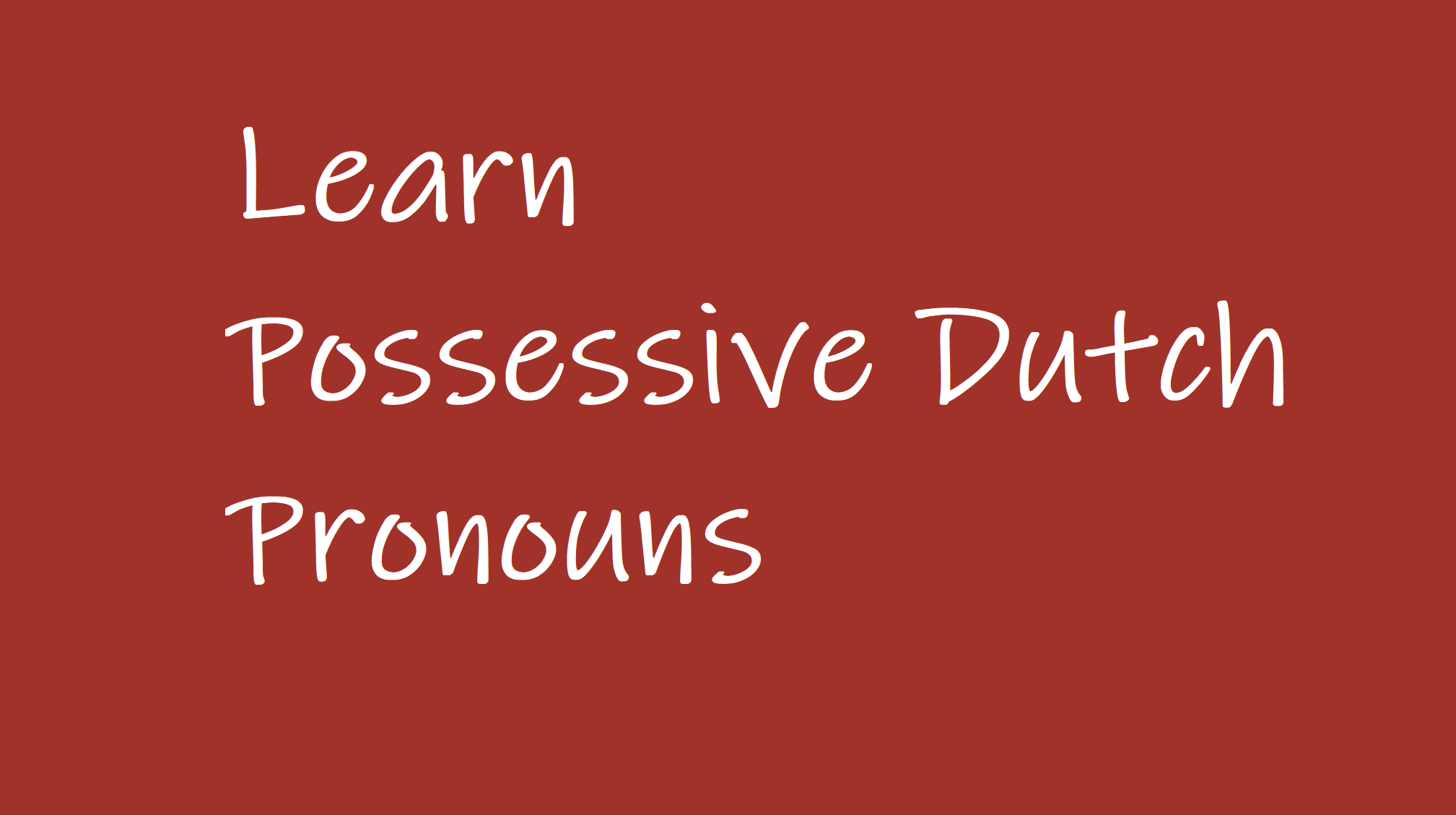
PPT Dutch Possessive pronomen and direct/indirect object pronomen A1/2 Teaching Resources
The object personal pronouns follow the same rules as the subject personal pronouns. This time, we have an emphasized (mij) en a non-emphasized form (me) to refer to the first-person singular.Referring to things. When referring to things in the singular form, we use het for het-words, and hem for de-words.Occasionally, also haar can be used to refer to de-words.

Learn Dutch possessive pronoun / Dutch lessons / Nederlandse les / bezittelijk voornaamwoord
In this video, I'll show you how you can express possession in Dutch. I'll talk about possessive pronouns (bezittelijke voornaamwoorden) as well as a second.

PPT Dutch Possessive pronomen and direct/indirect object pronomen A1/2 Teaching Resources
Dutch Possessive Adjectives and Pronouns. Possessive pronouns indicate to whom an object belongs. If I say this is my pencil, the pencil apparently belongs to me. 'My' is a possessive pronoun. English: Dutch: my: mijn: your: je /[marked] jouw: your [formal] uw: his: zijn: her: haar: its: zijn: our: ons/onze: your: jullie/je:

Dutch phrases Lesson 11 Possessive adjective + demonstrative pronoun
As in English, Dutch personal pronouns still retain a distinction in case: the nominative (subjective), genitive (≈ possessive) and accusative/dative (objective). A distinction was once prescribed between the accusative 3rd person plural pronoun hen and the dative hun , but it was artificial and both forms are in practice variants of the same.

Possessive pronouns in Dutch Dutch 101 YouTube
There are different types of pronouns, but for possession, there are two ways to go about it. You can use the possessive pronoun (third column) or you can use van + personal pronoun in non-subject form (second column). Dit is mijn hond. ( This is my dog) Deze hond is van mij. (This dog is mine)

Het bezittelijk voornaamwoord (het possessief pronomen) bijvoeglijke vormen / Possessive
Possessive Pronoun Forms. Possessive pronouns in Dutch vary according to the gender and number of the noun they are associated with. They also correspond to the person (first, second, or third) and the subject's gender. In Dutch, there are three genders: masculine, feminine, and neuter. Additionally, possessive pronouns can be singular or plural.

Possessive Pronouns in Dutch Grammar TalkPal
Possessive pronouns are used to show that something belongs to someone or a group of someones. The possessive pronouns are always used when people are the one's doing the possessing. In Dutch, the possessive pronouns also come in emphasized and unemphasized varieties. Just like with the subject pronouns (link to post about subject pronouns) the.

Dutch personal pronouns that mean YOUR Learn dutch, Personal pronouns, Dutch words
️Enroll in the Online Beginners' Course for a LOT of EXTRA MATERIALS! https://learndutchwithkim.teachable.com/p/dutch-beginners-course ️For more courses and.

Dutch POSSESSIVE PRONOUNS // Bezittelijke voornaamwoorden // Dutch for BEGINNERS les 14 (NT2
In this video we will focus on the possessive pronouns. After a short definition, the actual pronouns and some examples you will be able to use them in your.
Possessive pronouns Dutch(English) Flash cards
SIL International. Just like in English, the Dutch use independent possessives. An independent possessive does not precede a noun, as in "It is my pencil", but stands alone: "It is mine ". The independent possessive is only used when the possessor is a person. For 'its' and plural 'yours', the Dutch do not have independent possessive pronouns.

Dutch Lesson 09 Posessive Pronouns YouTube
To form the possessive pronouns, add -e to the stressed forms (except for jullie) and use the correct article. The only way to show possession with jullie is to use van jou (literally meaning "of you"), although all the others can be used with van too. de/het mijne, jouwe, uwe, zijne, hare, onze, hunne (mine, yours, yours, his/its, hers, ours.

Possessive Dutch pronouns Blogcontent Everything about work and life in the Netherlands
All Dutch possessive pronouns (in free online video YouTube): mine, your, his, her, our, your, their. What is the difference between 'onze' and 'ons'? With e.

Possessive Pronouns in the Dutch language YouTube
hun, hen. The pronouns in Dutch are used very similarly to those in English, with an exception for the use of the T-V distinction, which means that there is use of formal and informal pronouns. When referring to somebody politely, u is used; jij is used in less formal situations. The third person singular hij is equivalent to ''he.

Possessive in Dutch learn them all YouTube
In Dutch, we also add the letter 's' to the proper name. There are two differences between Dutch and English. In Dutch: We can only turn proper names into possessive nouns. Andrew's bicycle is possible, but my neighbour's bicycle is not. We only use an apostrophe if the name ends in a vowel (with the exception of the mute e) or the letter s .

Lesson 3 Possessive Pronouns and Telling the Date in Dutch Teaching Resources
In Dutch, we have another way of saying that something belongs to someone. In English, we do not say: "This book is of me" but in Dutch this is a very common expression. In Dutch, we do not have a separate form for 'its'. The translation of 'of it' is 'ervan' (see pronominal adverbs ). If we want to stress that something belongs to 'it', we say.

What Is A Possessive Pronoun? List and Examples of Possessive Pronouns • 7ESL Possessive
You'll have to study them and practice! Luckily we have a nice overview for you and some exercises! Last edit: Tue Oct 17 2023 TDOA Dutch Grammar Pronouns in Dutch: 4 types you need to know. Share&Save. Hij/Ze/Zij/Het.